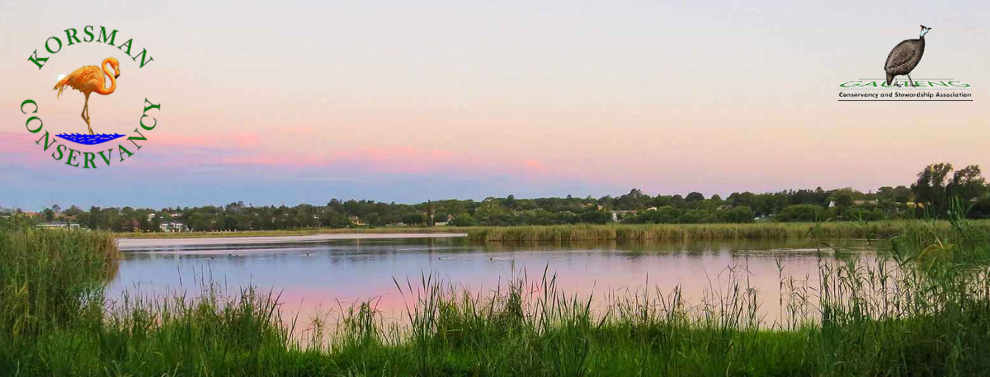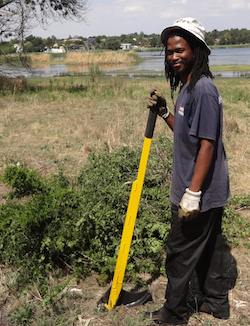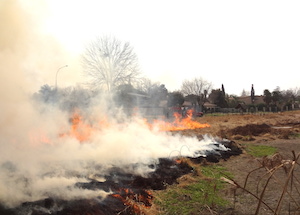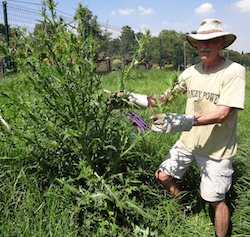
KORSMAN CONSERVANCY
Invasive Plants and Removal Methods
PRESENT STATUS
Control phase - Drastic reduction of existing population:
Jerusalem cherry (Solanum pseudocapsicum) Purple Top (Verbena Bonariensis) Moth catcher vine (Araujia sericifera) Weeping Willow (Salix Babylonica) Blackjacks (Bidens pilosa, Bidens bipinnata).
Follow-up phase - Control of seedlings, root suckers and coppice growth (no plants go to seed):
Spear Thistle (Cirsium vulgare) ongoing monitoring for seedlings.
Pompom weed (Campuloclinium macrocephalum) monitoring from December and immediate removal of isolated plants.
Red sesbania (Sesbania punicea) - seedlings removed while small. Seed banks usually underwater sprout when water levels drop.
Bugweed (Solanum mauritamium) - seedlings removed before going to seed.
Black Locust (Robinia pseudoacacia) - saplings removed by tree popper.
Ongoing Threats
Kikuyu has the potential to overwhelm indigenous grassland. Common Reed (Phragmites Australis) and Bulrush (Typha Capensis) have spread due to high water levels and nutrient-rich water from sewerage spills.
Uncategorised alien trees and weeds which have become locally invasive: American Ash (Fraxinus americana), Chinese Elm (Ulmus parvifolia) and Chinese Maple (Acer buergeranium) Fleabane (Erigeron bonariensis) Blackjacks (Bidens pilosa, Bidens bipinnata).
Populations newly under management: Saltmarsh Aster (Symphyotrichum squamatum), Curly Dock (Rumex crispus), Heliotropium amplexicaule, Acalypha species, possibly A. alopecuroidea.

Manual methods
Tree Popping
For saplings not propagated by runner, ie. American Ash, Chinese Elm, Chinese Maple, Privet, Chinese Stinkwood.
Weeding and slashing
Regular inspection from spring until autumn.
Spear Thistle - October to May. Dig out before flowering, otherwise cut and bag flowers. Consistent effort has dramatically reduced the infestation.
Pompom weed - inspect from summer onwards. Dig out bulbous roots. Flower heads must be removed and bagged.
Moth catcher - remove as much root as possible. Fast grower! Do not allow to bear fruit.
Fleabane - pull out from December onwards. Don't break it off - remove the crown at least. Not categorised as invasive but has the potential to overwhelm grassland at Korsman.
Blackjacks - slash large areas before seeding. Several treatments may be needed per season, depending on rainfall and growth. January-May.
Curly Dock - slash plants while flowering to prevent seed maturing.
Below: Spear Thistle - taller than the volunteer who dug it out
Phragmites Control by Cutting and Flooding Patches of reeds in water have been successfully controlled by brush cutter slashing in Spring, while the water level is low. When the water level rose after rain and covered the cut stumps, the plants did not regrow.
Ring barking / bark peeling has been successful on Australian Blackwood, but unsuccessful on American Ash (resprouted from roots) because the bark was not peeled back far enough below soil level.
Controlled Burning to remove sprayed kikuyu and stimulate indigenous growth. See Ecological Burning Plan
Burning is an essential aspect of veld management, but challenges at Korsman are:
- Urban area
- Proximity of fence
- Proximity of reed beds
Biocontrol: Not yet used at Korsman.
During the Red Water Fern (Azolla filiculoides) infestation in 2014, we tried to source Frond Feeding Weevil but the program has been so successful in South Africa that none was available. The infestation abated during 2015, as weevils possibly arrived on their own.

Korsman Conservancy 2018 Invasive Species Control and Management Plan as required by Section 76 of NEMBA



